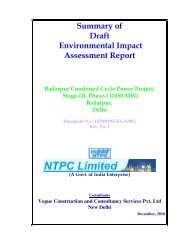350 MW Pragati-II Combined Cycle Power Project of PPCL
350 MW Pragati-II Combined Cycle Power Project of PPCL
350 MW Pragati-II Combined Cycle Power Project of PPCL
- No tags were found...
Create successful ePaper yourself
Turn your PDF publications into a flip-book with our unique Google optimized e-Paper software.
Rapid Environmental ImpactAssessment Study <strong>of</strong> the Proposed<strong>350</strong> <strong>MW</strong> <strong>Pragati</strong>-<strong>II</strong> <strong>Combined</strong> <strong>Cycle</strong><strong>Power</strong> <strong>Project</strong> <strong>of</strong> <strong>PPCL</strong>Doc. No.: CW-EN-9384-C-379-E-R-002Rev. No.: R0Issue Date: 21-02-2006Page No: 11 <strong>of</strong> 1611.2 WATER USE AND WATER QUALITYThe requirement <strong>of</strong> raw water for Construction purpose will be met through treatedsewage from Okhla Sewage Treatment Plant.During Operation Phase, the requirement <strong>of</strong> raw water will be met through existingtreated sewage from Okhla Sewage Treatment Plant. The concentrations <strong>of</strong> toxicsubstances in the treated wastewater will be well within the limits specified standardsfor Discharge <strong>of</strong> Effluents. As fresh water sources will not be tapped, therefore, therewill be no impact on ground water and fresh water system.11.3 DEMOGRAPHY AND SOCIO- ECONOMICS11.4 SOILManpower requirement for operating the facilities has been estimated as 90 persons.During the construction phase, the peak labour force requirement is estimated as300-<strong>350</strong> persons, who will be available from local labour force. Thus, any impact ondemographic pr<strong>of</strong>ile <strong>of</strong> the area through influx <strong>of</strong> job seekers is insignificant. Due toits low employment potential the proposed project will not put additional burden onother socio economic factors like price <strong>of</strong> essential commodities, occupationalpattern, health & educational facilities, transport and communication net work etc.As the proposed plant will be located at ash dyke, there will not be any loss <strong>of</strong>topsoil. Handling <strong>of</strong> construction materials such as cement, sand etc. shall beconfined <strong>of</strong> the area <strong>of</strong> construction only. There will be no impact on the soil duringoperation.11.5 AIR QUALITYGeneration <strong>of</strong> Particulate Matter due to excavations, handling and transport <strong>of</strong> earthand construction materials, movement <strong>of</strong> construction equipment and traffic etc. willbe the main pollutants during the construction phase. However, the impact is likely tobe for short duration and limited to the construction site only.The maximum predicted incremental GLCs for NOx is 3.78 µg/m 3 and this would beobserved in the SE direction at a distance <strong>of</strong> 1 km.The resultant maximum GLC for NOx after implementation <strong>of</strong> CCPP <strong>II</strong> are estimatedto be 24.78 ugm/m3. This value is within the National Ambient Air Quality Standardsfor residential area.11.6 TERRESTRIAL ECOLOGYAs the study area is devoid <strong>of</strong> natural forests, the overall impacts on terrestrialecosystem (e.g. loss <strong>of</strong> flora and fauna) will be negligible. The site and area aroundthe site will experience some increase in pollution SPM. Deposition <strong>of</strong> fugitive duston pubescent leaves <strong>of</strong> nearby vegetation may lead to temporary reduction <strong>of</strong>photosynthesis. Such impacts would, however, be confined mostly to theconstruction phase and would also be regulated and minimized through adoption <strong>of</strong>EXECUTIVE SUMMARYMANTEC CONSULTANTS (P) LTD., NEW DELHI
















